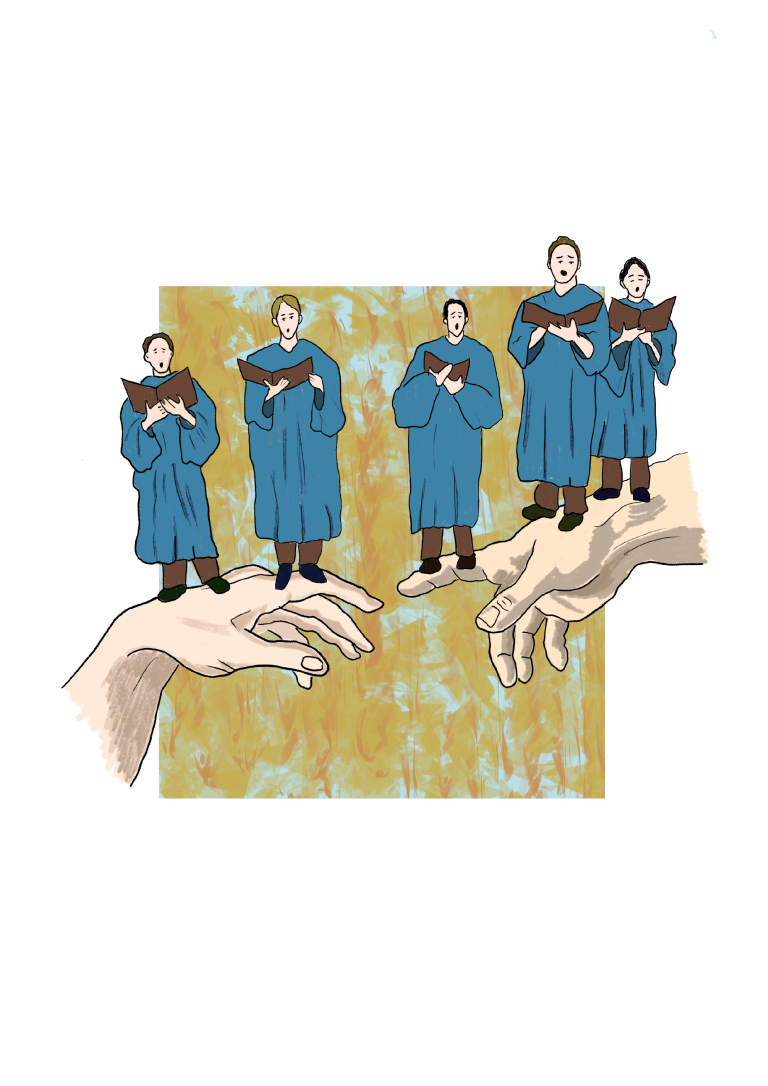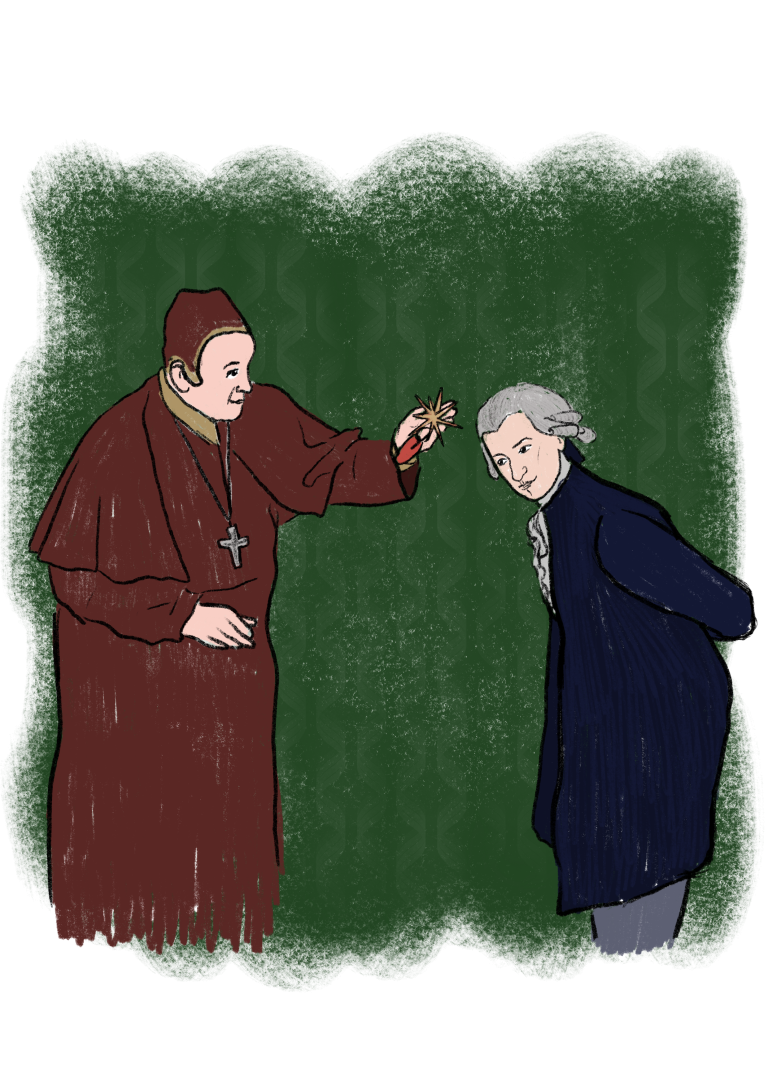
The perfect crime was committed. Only the Genius could have done it. It was such an incredible feat that when the victim heard what happened, he rewarded the thief.
Episode 2 - Crime and no punishment - W.A. Mozart and Allegri's Miserere
Short Summary
In the second episode of the Danetkas: Crime and No Punishment podcast, a riddle involving the perfect crime is presented.
The image suggests a choir singing in a church setting. Hints from Mr. Rigoletto lead to the revelation of a historical incident related to the Miserere composed by Gregorio Allegri for the Sistine Chapel during the 1630s. Wolfgang Amadeus Mozart, a child prodigy, transcribed the forbidden music, impressing the Pope, who lifted the ban and rewarded Mozart.
The episode explores Mozart’s musical genius, his early fame through European travels, and challenges in preserving the authenticity of Allegri’s Miserere.
In this episode of the Danetkas podcast hosted by Francisco Chaves, the focus is on the Danetka titled “resourcefulness.” The riddle involves a dance recital where the composer replaces musicians with tools and materials. The host introduces three hints (Rigolettos) to solve the riddle:
- Working with what you have,
- The key to success is good preparation
- A piano that was not heard.
The answer reveals that a musician, constrained by a limited budget and stage space, used rubber, plastic, bolts, and screws between piano strings to create percussive sounds, leading to the concept of the “Prepared piano” by composer John Cage.
The podcast then features Portuguese pianist Mariana Miguel, an expert in the field of the prepared piano, discussing her experiences, inspirations, and compositions related to this unique musical approach. Mariana shares insights into her album “Piano Oceano,” inspired by water, and explores various aspects of working with prepared piano, emphasizing resourcefulness and creativity. The episode includes excerpts of Balinese gamelan, Mariana’s compositions, and concludes with reflections on John Cage’s influence and the importance of inspiring creativity.
Hello and welcome to the second episode of Danetkas: crime and no punishment.
I will start by reading out the riddle to you. The riddle says the following:
The perfect crime was committed, only the genius could have done it. It was such an incredible feat that when the victim heard what happened he rewarded the thief.
We have an image that accompanies these riddle I will describe the image for you: The image seems like a choir singing with some hands that some people might recognize it from an artwork of Leonardo Da Vinci maybe you recognize this image where could you find a choir singing. Here are the questions that you need to solve: What was the crime? Who was the Genius and why did the victim reward the thief?
It’s very unusual that the victim rewards the thief. What hints do we have here?
So a choir usually can be found in churches singing so maybe the story relates a bit to the church. What hints can Mr. Rigoletto give us? The first hint that Mr Rigoletto will provide us says:
This sinner violated the sacred law.
hmm so the sinner might be the thief, right? So he made a crime and violated the sacred law so maybe there was a religious law of some sorts there to find out what it was.
The second Rigoletto says:
Copyright infringement? In those times?
Hmm copyright infringement so that means that he stole, copied something down, maybe he didn’t pay the authors for their author rights so he copied music perhaps he stole music from someone but like I said the victim rewarded the thief so that still seems unexplained.
We thought he was a sinner but he helped propagate the Faith. That was the third Rigoletto.
We thought he was a sinner but he helped propagate the Faith.
So actually by committing this crime the thief, apparently, sinner propagated the Faith.
So he copied something, maybe, and by doing this he helped propagate the Faith.
Do you have any idea of what might have happened? I will read now the answer for you:
A secret chant performed only during the Holy Week in the Sistine Chapel was forbidden from being written down for more than a century the absence of scores guaranteed endless curiosity and mysticism which made the music very popular.
A child with extraordinarily talents managed to write down the music by hearing it only once.
Later the pope found out what he did but he got so impressed by the talent of the young musician that he lifted the band and published the scores this helped propagate the secret music. Austrian composer Wolfgang Amadeus Mozart received a medal and got the title of knights of the Vatican.
Here’s some additional information about this story so this story is actually about the Miserere of composer Gregorio Alegri. The Miserere was composed during the reign of Pope Urban the eight (VIII) probably during the 1630s for the exclusive use of the Sistine Chapel during the Tenebrae services of Holy Week so the image was actually an image from the Sistine Chapel which is present in Rome, Italy. The original ornamentations that made the work famous were Renaissance techniques that preceded the composition itself and they were closely guarded by the Vatican.
Few written sources showed the ornamentation and it was this that created the legend of the works mystery. So, actually, the music that was written down was very often ornamented and in the Sistine Chapel these singers were very famous and their ornamentations were legendary. They were not written down, these ornamentations. So that’s why the transcription of Mozart was super important because it was a transcription of these ornaments, these extra notes, that the singers add to the composition. There were three authorized copies of the work distributed prior to 1770 to the Holy Roman Emperor Leopold the first, to the king of Portugal John the 5th and to Giovanni Batista Martini, however it was thought that none of the three successfully captured the piece as performed annually in the Sistine Chapel. According to the popular story, backed by family letters, 14 year old Wolfgang Amadeus Mozart was visiting Rome when he first heard the piece during the Wednesday service later that day he wrote it down entirely from memory returning to the chapel that same Friday to make some minor corrections.
I must say that as a musician this is incredibly hard to do, especially for a 14 year old, so that’s why only the Genius could have done such a crime. Less than three months after hearing the song and transcribing it, Mozart gained Fame for the work and was someone back to Rome by Pope Clement the 14th (XIV) who showered Praise on him for his feet of musical genius and the awarded him the Chivalric Order of the Golden Spur on the 4th of July 1770.
The Genius of Mozart is something unparalleled in the history of classical music. This genius is due to the education that his father Leopold Mozart gave him. As a child, Mozart was forced to practice by his father the violin, piano, composition, Harmony, Counterpoint and many other musical subjects as well as the siblings of Mozart.
The sister of Mozart was also an accomplished pianist and performed many of Mozart’s works.
Mozart’s father Leopold wanted to show the talents of his kids to all the courts in Europe. As little children they were traveling for years throughout Western Europe. Can you imagine what it was like traveling in the 18th century? Without cars? going on carriages for months and months on end with small children? This Journey to the Sistine Chapel in Rome is not uncommon for the Mozart family since they were used to travel a lot throughout Europe.
That’s how Mozart got famous he was famous throughout all Europe. He was a legend. A superstar because his father made him perform for the most important Aristocrats in Europe. That’s how Mozart became a legend. But how did the music of Allegri sound like? Of course it’s impossible to know for sure since there are no recordings at the time and the technology was not developed and the score does not show the ornaments. Actually, it’s even more complex than that because the current version differs quite significantly from the manuscript of Allegri. Many other versions (exist) nowadays. Many choirs, sing a kind of compilation of all of those versions. Some of them even have mistakes in them and those mistakes have been passed down through generations so musicologists have debated a lot and one of those mistakes actually became ingrained in popular culture. In this piece one of the striking moments is when the soprano, the top female voice, sings a very very very high note almost impossible to achieve and it sounds incredibly beautiful. It’s the climax of the piece.
However musicologists say that this high note was a transcription error passed down throughout generations. Personally this is a beautiful piece and one of my favorite choral pieces of all time. It gives me chills every time I hear it. I will finish this podcast by showing you a version of the Marion Consort. They try to implement some ornaments that could have been used in the Sistine Chapel. Before I present you with the recording, I will repeat the Danetka one more time so you can play with your friends and family, now as the master.
The Perfect Crime was committed only the genius could have done it. It was such an incredible feat that when the victim heard what happened, he rewarded the thief.
Miserere Mei, Gregorio Allegri, performed by the Marion Consort.
